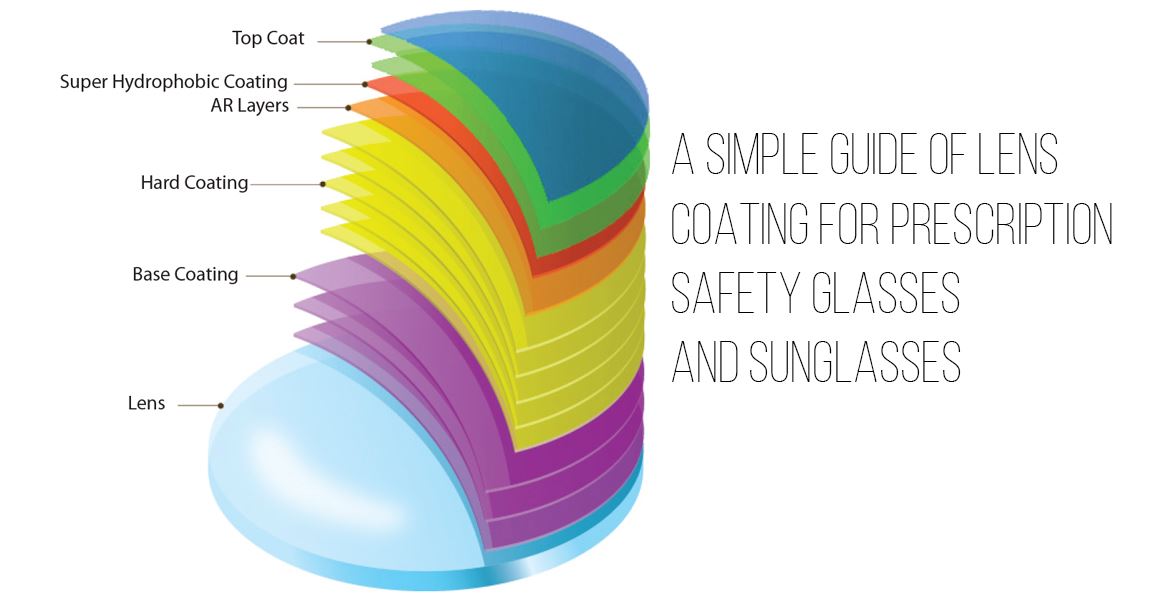In simple terms, a lens coating is precisely what the name implies, an ultra-thin layer of material added to the front and back surface of a lens to either protect it from scratches or UV rays and so on, depending on the use.
Types of Eyeglass lens coating
Eyeglass lens coating comes in different forms depending on what they do. Below are some of the Eyeglass lens coatings
- Anti-reflective coatings.
- Anti-fog coatings.
- UV-protection.
- Scratch-resistant coatings.
- Blue light filtration coatings.
- Photochromic treatment.
Anti-reflective coatings
Anti-reflective coating eliminates any reflection from the surfaces of the eyeglass lens. It is also known as AR or anti-glare coating, a fragile multilayer coating that gets rid of reflections from the front and back surfaces of the lenses. By doing so, AR coating makes your lenses nearly invisible so people can focus on your eyes, not distracting reflections from your eyeglasses.
Anti-reflective or anti-glare coatings work to enhance the appearance of your lenses and improve the clarity of your vision. AR coating is highly recommended for all eyeglasses lenses, particularly for polycarbonate and high-index lenses, which reflect more light than regular glass or plastic lenses if the anti-reflective coating is not applied.
Eye care professionals usually recommend applying an anti-reflective coating to photochromic lenses for the best possible comfort in all lighting conditions.
Advantages of Anti-reflective coatings lenses.
- When used in sunglasses, the anti-reflective coating reduces the glare from sunlight reflecting in our eyes from the back surface of the sunglasses.
- Anti-reflective lenses can also provide surface treatments that can make the lens prevent it from oil spots.
- Anti-reflective lens coatings also include surface treatments that make the lenses Hydrophobic (preventing the lens from water spots) thus easier to clean.
Anti-fog coatings
In the cold months, it can be frustrating when your glasses constantly fog up every time you step outside. Fogginess limits your ability to see, which can be dangerous, especially when you’re outdoors or driving. This is even more dangerous for police officers and people who respond to emergencies. Even if you don’t live in a cold climate, your lenses may fog up during sports activities or when you are hot and perspiring or when wearing a face mask.
So, to keep you out of harm’s way, you may want to consider upgrading your eyeglasses lenses with an anti-fogging treatment. It reduces condensation so your vision will remain clear even if you’re going inside a warm room or when you’re hot and perspiring.
Advantages of Anti-fog coatings
- During sports, when you are hot and perspiring, the coating prevents fogging too.
- Anti-fog coating helps you make a clear transition from cold to warm climate.
- The anti-fog coating can be applied on plastic, polycarbonate, and photochromic lenses.
- Anti-fog coating glasses help increase visibility.
UV-protection coating
UV radiation comes from the sun, which is very harmful to our skin. UV radiations can also affect our eyes. Excessive exposure to UV can cause inflammation in the cornea or sunburn in the eye. In addition, UV exposure has been linked to age-related eye problems like cataracts and macular degeneration. Lenses that block 100% of UVA and UVB rays can help prevent the damaging effects of UV radiation.
Types of UV light
- UV-C has a very short wavelength, so it packs the most punch. But UV-C from the sun is absorbed by the earth’s ozone layer; this type can be avoided in most places.
- UV-B has a short wavelength and is the most dangerous ultraviolet light to come through the atmosphere.
- UV-A has the longest wavelength of the ultraviolet spectrum, making it less harmful than UV-B light. However, prolonged exposure can still damage our eyes.
Scratch-resistant coatings.
Scratched lenses are distracting and can affect your ability to see clearly. Today, many eyeglass lenses have built-in scratch-resistant coatings, including high-index lenses and lenses made of polycarbonate and Trivex. These lenses are treated front and back with a clear, scratch-resistant coating and have a much harder surface. In addition, kids’ lenses benefit from a scratch-resistant hard coating for more outstanding durability.
However, lenses treated front and back with a clear, scratch-resistant coating have a much more rigid surface that is more resistant to scratching, whether from dropping your glasses on the floor or occasionally cleaning them with a paper towel. As a resu8ult, no eyeglass lenses — not even glass lenses — are 100% scratch-proof.
Advantages of Scratch-resistant coatings.
- It provides a clear vision.
- It prevents scratches and scrapes on the surface of the glasses.
- It also makes the lens more durable.
How to remove scratches from the lens.
Scratch-resistant coating cannot prevent scratches completely. To make sure you avoid scratches on your glass, you should always:
- Clean the glasses regularly with appropriate cleaning materials.
- Use a cloth that comes with your eyeglasses and not a shirt/paper towel.
- Make sure to put your glasses in their case when you are not using them.

